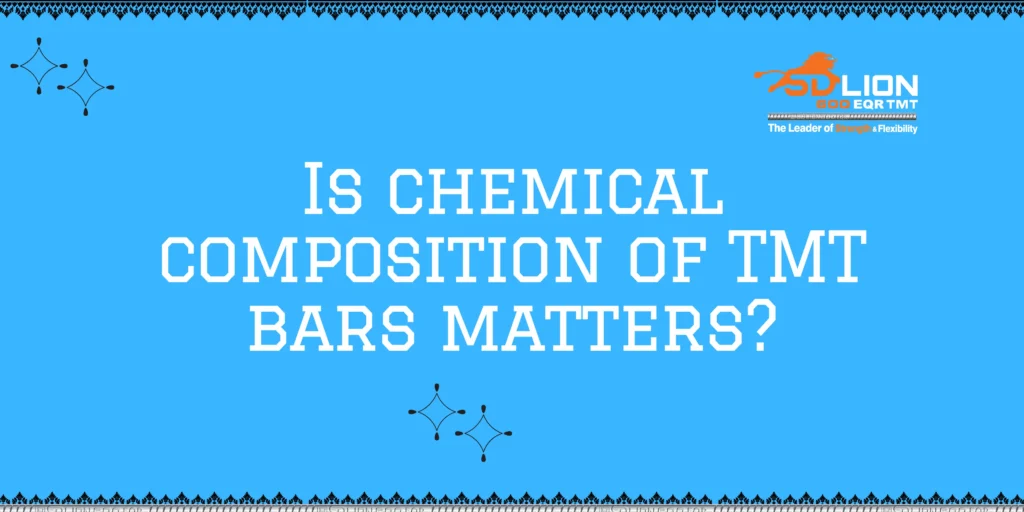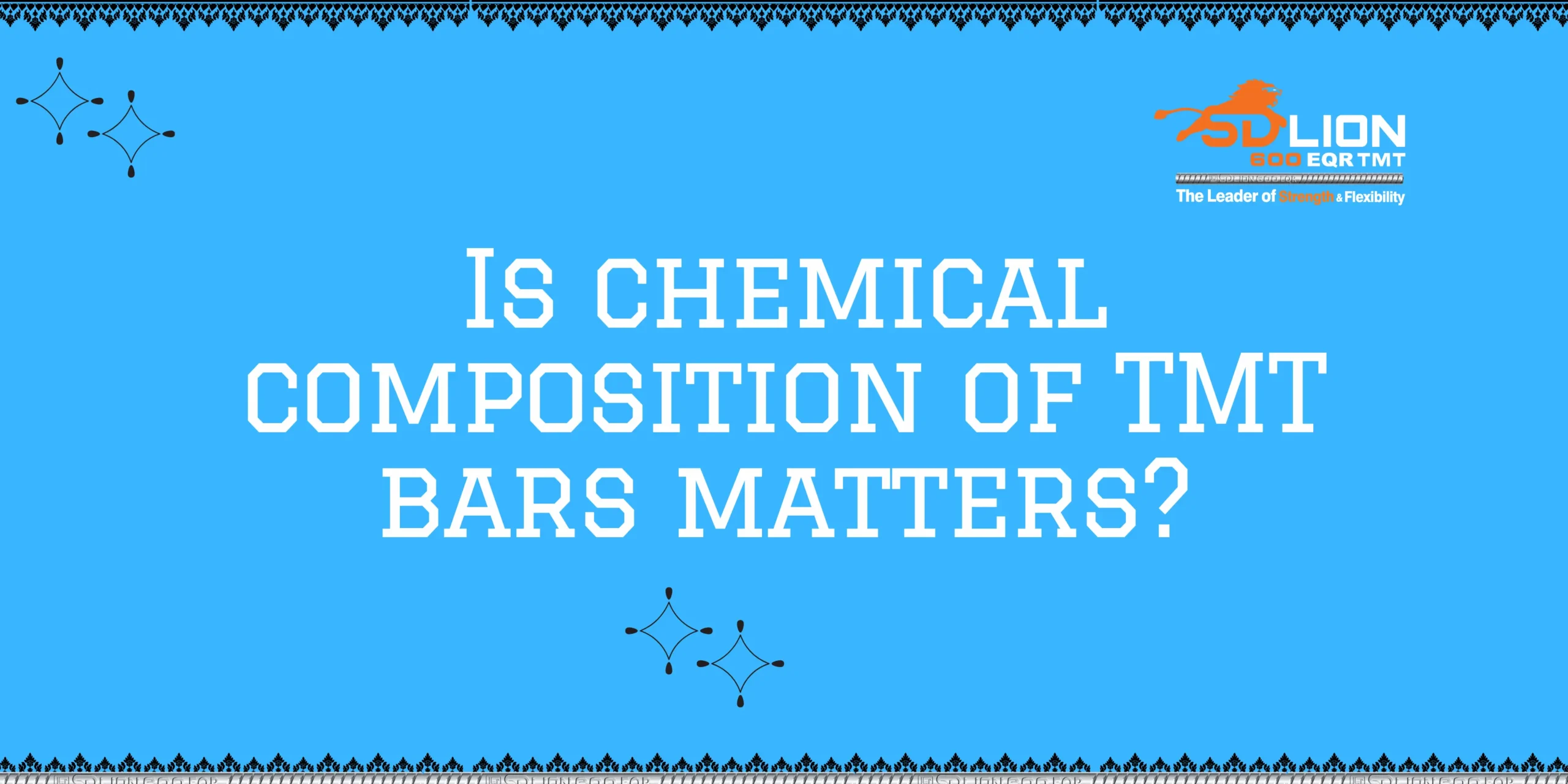
In modern infrastructure, steel reinforcement plays a vital role, and Thermo Mechanically Treated (TMT) bars are widely recognized as the gold standard for this purpose. From skyscrapers to homes, TMT bars are the strength behind concrete.
The reliability and strength of these bars lie in their chemical composition, which determines performance, longevity, corrosion resistance, and earthquake adaptability.
🔬 What Is the Chemical Composition of TMT Bars?
The chemical composition refers to the specific mix of elements like carbon, sulphur, phosphorus, manganese, silicon, chromium, copper, and nickel, with iron as the base.
🧪 Key Elements in the Composition
1. Carbon (C)
2. Sulphur (S)
- Function: Unwanted impurity
- Effect: Causes brittleness and cracks
- Limit: ≤ 0.040%
3. Phosphorus (P)
- Function: Reduces ductility & toughness
- Limit: ≤ 0.040%
4. Manganese (Mn)
- Function: Improves strength, prevents sulphide inclusion
- Range: 0.5% – 1.2%
5. Silicon (Si)
- Function: Increases strength & toughness
- Limit: 0.05% – 0.35%
6. Copper (Cu), Nickel (Ni), Chromium (Cr)
- Function: Improve corrosion resistance
- Use Case: Ideal for coastal/marine construction
🧾 Typical Chemical Composition (Fe 500D)
| Element | Maximum % Allowed |
|---|---|
| Carbon | 0.25 |
| Sulphur | 0.040 |
| Phosphorus | 0.040 |
| S + P | 0.075 |
| Manganese | 0.5 – 1.2 |
| Silicon | 0.05 – 0.35 |
| Carbon Equivalent (CE) | ~0.42 |
📈 How Chemical Composition Affects Properties
- Tensile Strength: Balanced carbon and manganese increase strength
- Ductility: Reduced carbon, increased Mn & Si improve bending capacity
- Weldability: CE below 0.42 allows easy on-site welding
⚖️ IS:1786 Standards
The IS:1786 standard in India mandates the permissible range for all elements in TMT bars. This ensures national safety and consistency.
- IS certification & stamping
- Mill Test Certificates (MTC)
- Carbon Equivalent (CE) < 0.42
🧱 Impact of Poor Composition
- Cracks in beams & columns
- Faster corrosion in marine zones
- Poor weldability
- Seismic failure risk
🧑🔬 Industry Best Practices
- Ask for IS:1786 compliance
- Demand test reports
- Request Cu, Cr, Ni additions for coastal projects
🏗️ Use Cases
- High-Rise Buildings: Use Fe 550D/Fe 600 with low carbon
- Dams & Bridges: High Mn and Si for strength
- Coastal Areas: Add Cu, Ni, Cr for corrosion protection
🌍 Global Standards Comparison
Similar to IS:1786, other standards include:
📌 Checklist
- Carbon < 0.25%
- Sulphur ≤ 0.040%
- Phosphorus ≤ 0.040%
- S + P ≤ 0.075%
- IS:1786 mark
- CE value < 0.42
💬 FAQs
Q: Does carbon alone determine strength?
A: No. Mn, Si, and P content also influence strength and ductility.
Q: How does composition affect corrosion?
A: Cu, Ni, Cr additions help resist rust in marine/coastal environments.
Q: Why is weldability important?
A: Low CE improves on-site flexibility and efficiency.
💡 Conclusion
The chemical composition of TMT bars is a core factor in building stable, long-lasting, and earthquake-resistant structures. Choose bars with certified standards, inspect the mill certificates, and understand the role each element plays in your project’s future.
Understanding the chemical composition of TMT bars is essential for ensuring structural integrity, as it directly impacts tensile strength, ductility, weldability, and resistance to corrosion. When purchasing steel for construction, engineers and contractors look closely at the chemical composition of TMT bars because small variations in elements like carbon, sulfur, phosphorus, manganese, silicon, and trace alloying metals can dramatically alter performance under load and during seismic events. For example, excessive carbon content in the chemical composition of TMT bars can increase hardness but reduce ductility and make welding more difficult due to a higher carbon equivalent value. Conversely, optimal manganese and silicon levels improve toughness without sacrificing flexibility, which is why quality control during manufacturing focuses intensely on the chemical composition of TMT bars.
Additionally, the presence of elements such as copper, nickel, or chromium within the chemical composition of TMT bars enhances corrosion resistance, making them suitable for coastal or chemically aggressive environments. Builders and quality inspectors often cross-reference mill test certificates against project specifications to verify that the declared chemical composition of TMT bars matches the actual delivered steel.
Deviations from acceptable limits in the chemical composition of TMT bars can lead to unexpected brittleness, early cracking, or reduced service life of the structure. Moreover, the chemical composition of TMT bars affects long-term maintenance costs, because bars with higher impurity levels may corrode faster, weakening the bond with concrete and leading to premature deterioration. In regions with seismic risk, understanding the chemical composition of TMT bars allows designers to predict the ductile behavior of reinforcement, ensuring that columns and beams will yield and deform rather than fracture under extreme stress. This mechanical predictability hinges on the precise chemical composition of TMT bars. For coastal infrastructure projects, a controlled chemical composition of TMT bars that includes anti-corrosive additives can significantly extend the expected lifespan compared to untreated steel. When combined with proper concrete cover and anti-corrosion coatings, bars with optimized chemical composition of TMT bars provide excellent durability.
Finally, education and awareness about the significance of chemical composition of TMT bars empower stakeholders—owners, architects, and safety regulators—to demand certified materials and implement random sampling policies, which ultimately elevate construction standards and public safety.

